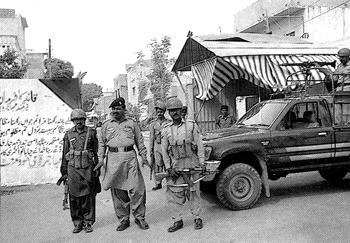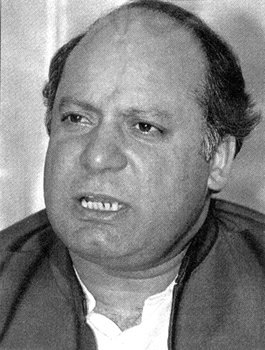

 |
As if this were not enough, after holding talks with the visiting Taliban leaders, Prime Minister Nawaz Sharif, along with the foreign minister and a battery of advisors, dashed off to Saudi Arabia to discuss the Afghan peace process. So when local newspapers, after the Pakistan Day holiday, came out on March 25, the headline stories read: �19 killed in Karachi�, �13 More die in Hangu� �One killed in Sindh Explosions� and �PM dashes to Saudi Arabia�.
As anticipated, the government neither achieved a breakthrough in its Afghan peace efforts, nor could it diffuse the violent situation on the domestic front. Eyewitness accounts of the evening of March 23 in Karachi were horrifying to say the least. Militants belonging to Altaf Hussain�s MQM and Afaq Ahmed�s Haqiqi group once again roamed Karachi�s killing streets with their well�oiled assault weapons. The almost casual manner in which one picked off the other party�s activists was proof enough, as if any were needed, that the rule of law is purely a concept that exists on paper alone in Pakistan. What was even more horrifying was the fact that while one of the parties involved is part of the provincial and federal administration, the other enjoys the unofficial patronage of the paramilitary forces.
The bloodshed of March 23 reminded many people in Karachi of the days when, after the withdrawal of the army in 1994, a savage turf war erupted between what were then the two factions of the Mohajir Qaumi Movement. Hundreds of lives were lost in the ensuing bloodbath, which eventually provided enough �justification� to the likes of General Naseerullah Babar to resort to extra�judicial killings. Ironically, many people in the establishment are now having second thoughts about their earlier criticism of General Babar�s way of dealing with militancy and terrorism.
Once again, the already alarming situation in Karachi is taking a turn for the worse. Casualty figures released by the Human Rights Commission of Pakistan (HRCP) in its annual report for 1997 indicate a marked increase in organised and politically motivated murders in Karachi. According to the HRCP, 385 such killings officially took place in 1997, compared to 161 similar deaths the previous year. The unofficial figures are much higher and, the commission report adds, the methods of killing and torture are becoming increasingly horrifying.
The Hangu incident in the North West Frontier Province, though it was in no way connected to events in Karachi, was yet another slap on the administration�s face. For one thing, violence was expected in that remote town in Kohat district and yet the administration could do nothing to prevent it. And what is perhaps even more damning is the fact that the PML(N)�s National Assembly member from the area was directly involved in the whole episode.
The events that led to the attack on a Shia Nauroz procession on March 21 in Hangu, and the subsequent violent clashes between the two communities, clearly establish the role played the role PML MNA from Kohat, Javed Ibrahim Piracha. A leading member of the self�styled Supreme Sunni Council of the area, he was clearly the instigator of the anti�Nauroz strike call in Hangu. �March 21 will be the day of Jihad in Hangu, and if I survive, we will meet again�, Piracha told the editor of an Islamabad Urdu newspaper a day before the violence started. This strike call was an open challenge to the administration, and an indication that violence was very much on the cards, yet the authorities failed to act on time.
Helplessness is fast becoming the government�s hallmark in almost all matters concerning law and order. The seemingly endless sectarian killings in Punjab, the factional fighting in Karachi and the recent flare�up in Hangu have all added fuel to the fire of the political and religious intolerance raging throughout the country. In this growing culture of violence, the government�s role has largely been confined to that of a spectator completely helpless and hostage to the will of the militants.
As things stand, the government is basically confronted by two fundamental problems: the politically motivated violence in Karachi and the growing sectarian hatred in the Punjab. Along with these two major areas of conflicts, Islamabad also has to contend with occasional outbursts of sectarian violence in the northern region of the country as well as the return of the dacoit in interior Sindh. Senior establishment officials dealing with this internal security crises believe that there are about half�a�dozen organised militant groups in the country, some of which also have strong roots in their particular ethnic, religious or political constituencies. Heading the list, these officials say, are the Muttahida Qaumi Movement (MQM), the MQM (Haqiqi), the Sipah�e�Sahaba Pakistan and the Tehrik�e�Jafria (along with their respective offshoot, the Lashkar�e�Jhangvi and Sipah�e�Mohammad). This does not, however, imply that terrorism is the mainstay of every one of these organisations. In fact, a majority of their members have nothing to do with militant activities. However, the non�militant members of these parties, despite their numbers, are apparently not in a position to dictate terms.
Then there are the splinter groups of Jiye Sindh Movement, organisations that make little distinction between politics and crime. Relatively small but equally militant local level groups with the potential to create major trouble have cropped up in other areas as well, primarily in the Punjab and the sectarianism�prone northern region of the country. What has made matters even worse is the criminalisation of some of these militant movements. Lack of funding from original sources, or disillusionment amongst members who then indulge in �freelance� activities on the side, has led to their involvement in crimes such as armed robberies and bank hold�ups.
If Karachi has constantly remained hostage to the muscle of the MQM and the considerably smaller but equally militant Haqiqis, almost all the southern and central Punjab has been plagued by ceaseless sectarian strife between Sunnis and Shias. What started many years ago as essentially a vendetta between the leaders of the Sipah�e�Sahaba and the Tehrik�e�Jafria has since spilled over on to a much wider canvas. The extremist off�shoot of these two parties, groups such as the Lashkar�e�Jhangvi and the Sipah�e�Mohammad, has now brought the ongoing warfare to the doorsteps of ordinary Shias and Sunnis.
Lahore�s Mominpura graveyard massacre, the grenade attacks on mosque, or the mowing down of some lawyer or doctor in Faisalabad or Jhang are just a few examples of these phenomenon. Senior police officials in the Punjab accept that in the majority of recent cases, sectarian groups have targeted high�profile members of the two communities �lawyers, doctors and businessman, people who were clearly not themselves involved in sectarian politics. This is a frightening development, one that has the potential of gradually enveloping the two communities which despite the untiring effort of the militant groups, have so far stayed away from this conflict.
Prime Minister Nawaz Sharif�s initial recipe for dealing with this crises was to introduce tougher legislation, giving more power to the police and setting up special speedy trial courts to punish criminals in the shortest possible time. But criticism from human rights groups aside, the new law failed to create a mechanism that could check the activities of these elements. The special courts have to date dealt largely with routine murders and rapes, with hardly a handful of terrorism cases coming up for hearing. In fact, some of the more hardened elements have even managed to escape from jail, while a few others have gone into hiding after being released on bail.
All manners of militants have, meanwhile, been moving around at will, eliminating their targets and making a mockery of the entire administrative system. Incidents such as the brutal murder of five Iranian air force technicians in Rawalpindi, the gunning down of four American oil company employees in Karachi and the killing of another two Iranians in the same city, all took place after the passage of this new anti-terrorism law. Law and order experts agree that the situation is a highly sensitive and tricky one which does not lend itself to easy solutions. As with most sucessive governments, the present administration is also confronted with a Catch�22: the political cost of a crackdown. Another dilemma is who to target and in what order. Then there is also the question of how to deal with the political mileage that the main opposition party is bound to try and extract from events following a crackdown.
 |
Senior government officials say that the civil and military intelligence agencies can already identify most of the armed groups involved in ethnic and sectarian activities. Similarly, they are also familiar with the ways in which some of the deeni madaris have been fanning sectarianism, and how some businessmen and trading groups, as well as a few foreign countries, have been funding various militant parties.
Above all, analysts say, any action that is taken must be even-handed and across�the�board. Targeting MQM militants while patronising the Haqiqis, or cracking down on the SSP and allowing free rein to the TJP or the Sipah�e�Mohammad, is an ill-fated policy that has boomeranged in the past and is bound to do so again.
Militancy has become fairly deep-rooted in Pakistan and, as such, its elimination is a daunting task by any standard. But a well�orchestrated, two�pronged attack on both the political and administrative fronts may at least contain the problem.
Prime Minister Nawaz Sharif is undeniably in a tight spot. He wants to tackle the problem, not simply to restore peace in the country but also to create an atmosphere conducive to investments. And considering the kind of political support that he still enjoys, he clearly is in a position to do so. However, time may be running out fast and Sharif knows better then anyone else that good intentions alone can never resolve a crisis. He has to demonstrate the political will to take on the militants, or the coming days may prove to be even more gory than the bloodbaths being seen today.
Zaffar Abbas
(The writer is the Islamabad bureau chief of �The Herald�, Pakistan. The above article has been excerpted from an article in the magazine).